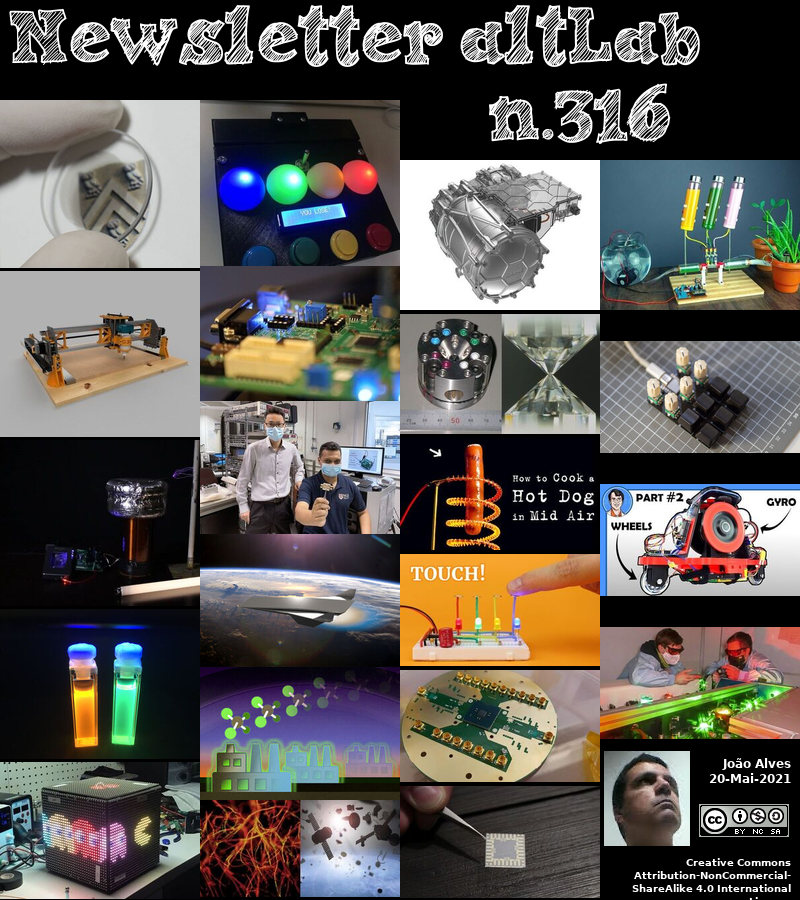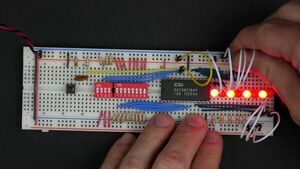2021-05-20 - Nº 316
Editorial
Esta é a Newsletter Nº 316 que se apresenta com o mesmo formato que as anteriores. Se gostar da Newsletter partilhe-a!
Todas as Newsletters encontram-se indexadas no link.
Esta Newsletter tem os seguintes tópicos:
Faz hoje anos que nascia, em 1851, o inventor germano-americano Emile Berliner. Ele fez contribuições importantes para a tecnologia do telefone e desenvolveu o disco de registo fonográfico, o microfone em 1877 e o gramofone em 1887. Enquanto Thomas Edison inventou os discos cilíndricos, Berliner teve a ideia de usar discos. Ele cunhou a palavra gramofone como marca registada. Mais tarde, ele tornou-se um pioneiro no desenho de helicópteros.
Faz também hoje anos que nascia, em 1860, o bioquímico alemão Eduard Buchner. Ele recebeu o Prémio Nobel de Química em 1907 por demonstrar que a fermentação de carboidratos resulta da acção de diferentes enzimas contidas na levedura e não na própria célula de levedura. Ele mostrou que uma enzima, a zimase, pode ser extraída das células de levedura e que causa a quebra do açúcar.
Faz igualmente hoje anos que nascia, em 1895, o desenhador de aeronaves britânico R. J. Mitchell. Ele desenvolveu o Spitfire de oito armas (1936), um dos caças mais conhecidos na Segunda Guerra Mundial. Ele foi engenheiro e projectista da Supermarine Aviation Works (1916-37), engenheiro-chefe (de 1919) e também era conhecido pelo projecto de uma série de lanchas e hidroaviões de alta velocidade. Nos anos de 1920 a 1936, ele projectou nada menos que 24 aeronaves diferentes. O Spitfire era um derivado de sua anterior aeronave de corrida de hidroaviões, a S.6B.
Faz também hoje anos que nascia, em 1901, o engenheiro japonês Hideo Shima. Ele projectou e supervisionou a construção do primeiro comboio "bala" de alta velocidade do mundo, ligando Tóquio a Osaka. Tendo começado a operar a 222 km/h em Outubro de 1964. A linha ferroviária abriu uma nova era no transporte terrestre. (A geração actual chega a 271 km/h). Shima liderou o programa de desenvolvimento espacial do Japão até 1977 na Agência Nacional de Desenvolvimento Espacial do Japão. Ele desenvolveu a força motriz eléctrica distribuída ao longo de todo o comprimento do comboio, tendo capacidade de gerar maior potência num comboio de várias unidades, sem danificar os trilhos e as estruturas.
Por fim, faz hoje anos que nascia, em 1913, o engenheiro electrotécnico norte-americano Bill Hewlett. Ele co-fundou a Hewlett-Packard Company, um fabricante líder de computadores, impressoras de computador e equipamentos analíticos e de medição. Em 1939, ele formou uma parceria conhecida como Hewlett-Packard Company com David Packard, um amigo e colega de classe de Stanford. O primeiro produto da HP foi um oscilador de áudio baseado num desenho desenvolvido por Hewlett quando ele estava na faculdade. Oito foram vendidos para Walt Disney para o filme Fantasia. A empresa começou com um capital inicial de $538 e sua primeira unidade de produção foi uma pequena garagem em Palo Alto.
Em 1498, Vasco da Gama chegava à Índia, tornando-se o primeiro europeu a chegar à Índia via Oceano Indico. Depois de partir de Lisboa a 8 de Julho de 1497, e de ter dobrado o cabo da boa esperança, Vasco da Gama com as suas quatro embarcações, acompanhado por Bartolomeu Dias chegaram dez meses depois a Kappakadavu, terra próxima de Calecute, ficando estabelecida a Rota do Cabo e aberto o caminho marítimo dos Europeus para a Índia.
Em 1927 o aviador americano Charles A. Lindbergh descola do Roosevelt Field em Long Island, Nova York, no primeiro voo solo sem escalas do mundo através do Oceano Atlântico. Este primeiro voo sem escalas entre Nova York e Paris demorou 33 horas e meia tendo percorrido cerca de 5800 km.
Em 1978 a NASA lançou para o espaço a sonda Pionner para fazer explorações em Vénus. Era um cilindro movido a energia solar do tamanho de uma banheira de hidromassagem.
Faz hoje 31 anos que o telescópio espacial Hubble enviava a sua primeira fotografia do espaço, uma imagem de uma estrela dupla a 1.260 anos-luz de distância.
E nesta semana que passou o rover chinês aterrou na superfície de Marte numa zona perto da Utopia Planitia. Foram partilhadas as primeiras imagens captadas pelo rover. O Zhurong chegou ao planeta vermelho no passado fim-de-semana.
 João Alves ([email protected])
João Alves ([email protected])
O conteúdo da Newsletter encontra-se sob a licença  Creative Commons Attribution-NonCommercial-ShareAlike 4.0 International License.
Creative Commons Attribution-NonCommercial-ShareAlike 4.0 International License.
Novidades da Semana
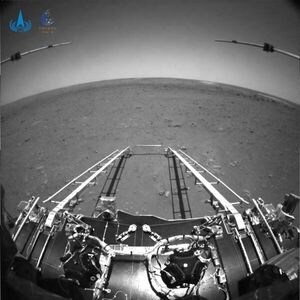
China's Tianwen-1 probe sends back Mars landing visuals
"Two photos and two videos captured by China's Mars probe Tianwen-1 during and after the country's first landing on the red planet were released by the China National Space Administration (CNSA) on Wednesday. The lander carrying a rover of the Tianwen-1 mission touched down in the southern part of Utopia Planitia, a vast plain on the northern hemisphere of Mars, on May 15, becoming the country's first probe to land on a planet other than Earth. The first photograph, a black and white image, was taken by an obstacle avoidance camera installed in front of the Mars rover. The image shows that a ramp on the lander has been extended to the surface of Mars. The terrain of the rover's forward direction is clearly visible in the image, and the horizon of Mars appears curved due to the wide-angle lens. The second image, a color photo, was taken by the navigation camera fitted to the rear of the rover." [...]
Outras Notícias
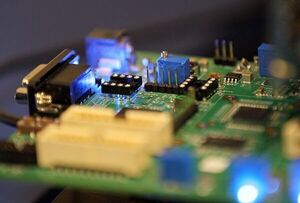
Taiwan’s TSMC claims breakthrough on 1nm chips
"Taiwan Semiconductor Manufacturing Co. (TSMC), National Taiwan University (NTU), and the Massachusetts Institute of Technology (MIT) have made a significant breakthrough in the development of 1-nanometer chips, reports said Tuesday (May 18). The joint announcement has trumped IBM’s statement earlier in the month about the development of a 2nm semiconductor, British website Verdict reported. While at present the most advanced chips are 5nm, TSMC’s find was likely to lead to power-saving and higher speeds for future electric vehicles, artificial intelligence, and other new technologies. The discovery was first made by the MIT team, with elements optimized by TSMC and improved by NTU’s Department of Electrical Engineering and Optometrics, according to a report in Nature Magazine. The key element of the research outcome was that using the semi-metal bismuth as the contract electrode of a two-dimensional material to replace silicon can cut resistance and increase the current, Verdict reported. Energy efficiency would thus increase to the highest possible level for semiconductors." [...]

Unveiling our new Quantum AI campus
"Within the decade, Google aims to build a useful, error-corrected quantum computer. This will accelerate solutions for some of the world’s most pressing problems, like sustainable energy and reduced emissions to feed the world’s growing population, and unlocking new scientific discoveries, like more helpful AI. To begin our journey, today we’re unveiling our new Quantum AI campus in Santa Barbara, California. This campus includes our first quantum data center, our quantum hardware research laboratories, and our own quantum processor chip fabrication facilities. Here, our team is working to build an error-corrected quantum computer for the world. Google began using machine learning 20 years ago (for spell checking in Search), and led the deep learning revolution 10 years ago (advancing neural nets, the leading approach to modern AI)." [...]

Qualcomm Announces World’s First 10 Gigabit 5G M.2 Reference Design to Accelerate 5G Adoption in New Segments
"Qualcomm Technologies, Inc., today announced the Qualcomm® Snapdragon™ X65 and X62 5G M.2 Reference Designs for accelerating 5G adoption across industry segments, including PCs, Always-Connected PCs (ACPCs), laptops, Customer Premises Equipment (CPEs), XR, gaming and other mobile broadband (MBB) devices. The new reference designs are powered by the world’s most advanced and first 3GPP Release 16 5G modem-RF solutions - Snapdragon X65 and X62 5G Modem-RF Systems – supporting unmatched spectrum aggregation, global 5G sub-6 and extended-range mmWave, and high power-efficiency. Built on the world’s first 10 Gigabit 5G solution, the Snapdragon X65 5G M.2 Reference Design brings state-of-the-art 5G capabilities to OEMs across mobile broadband product categories. These reference designs for a plug-and-play M.2 form factor allow OEMs to reduce time to launch for high-performance 5G-enabled products. “We’ve seen a dramatic growth in data consumption as a result of remote work and higher mobility. To help meet this data demand and create exciting new products and experiences, our new 5G M.2 Reference Designs tackle many 5G design complexities upfront so that OEMs don’t have to,” said Durga Malladi, senior vice president and general manager, 4G/5G, Qualcomm Technologies, Inc. “Qualcomm Technologies is committed to leading the acceleration and expansion of 5G beyond smartphones." [...]

Virgin Galactic today confirms Upcoming Test Flight of VSS Unity in May
"Virgin Galactic today confirmed that the next rocket-powered test flight of SpaceShipTwo Unity will be conducted on May 22, pending weather and technical checks. This follows the completion of a maintenance review of VMS Eve, the mothership jet aircraft designed to carry SpaceShipTwo to an altitude of approximately 50,000 feet. “Following a detailed inspection and thorough analysis of our mothership, Eve, we have cleared our Spaceflight System for our upcoming flight. I want to thank our incredibly talented team of engineers, maintenance crew, quality inspectors and support staff for their diligence and hard work, which is testament to our commitment to safety and the integrity of our flight test program,” said Michael Colglazier, Chief Executive Officer of Virgin Galactic. Virgin Galactic regularly monitors its vehicles to verify their condition and inform timing of future upgrades and modifications that can improve performance or reduce future maintenance work. A post-flight inspection of VMS Eve in early May called for further engineering analysis to assess a known maintenance item in the tail of the vehicle, which was scheduled to be addressed during the next maintenance period." [...]

Arduino Docs has all the info you ever need about Arduino boards
"The truth is, we never entirely got to grips with Arduino documentation. Until now. Now there’s a new standard for gathering together product info, tech specs and tutorials, that we’re calling Arduino Docs. We’re excited to share it with the Arduino community who’ll soon be able to help it grow. It Began with the Uno When the Arduino Uno was launched around 15 years ago, its detailed documentation was a vital part of its success. It wouldn’t be at all unreasonable to say that its online resources were a driving factor in the establishment and growth of the primordial Arduino community." [...]

The Arduino Nano RP2040 Connect is here
"It was back in January that we first introduced you to the Arduino Nano RP2040 Connect. The first Arduino board to include Raspberry Pi silicon. It’s been a roller coaster ride getting it to you, and enthusiasm during the wait has been incredibly encouraging. The wait, you’ll be glad to hear, is over. The RP2040 Processor Working with the Raspberry Pi Foundation is nothing short of a pleasure. The teams there make some incredible devices, and their first in-house silicon is no exception." [...]

Rocket Lab Progresses Flight Review, Recovers First Stage Following Successful Ocean Splashdown
"Rocket Lab Progresses Flight Review, Recovers First Stage Following Successful Ocean Splashdown On May 15, 2021, Rocket Lab experienced an anomaly almost three minutes into the company’s 20th Electron launch. Following a successful lift-off from Launch Complex 1, Electron proceeded through a nominal first stage engine burn, stage separation, and stage 2 ignition. Shortly after the second stage ignition the engine shut down, resulting in the loss of the mission. Rocket Lab continued to receive good telemetry from Electron following the safe engine shutdown on stage two, providing engineers with comprehensive data to review as part of a robust review into the anomaly. The extensive data is being methodically scoured to enable the review team to accurately pinpoint the issue and implement corrective actions for future missions. Rocket Lab is leading the flight review with the support of the Federal Aviation Administration (FAA); a structure that ensures Rocket Lab maintains a high degree of control over its return-to-flight schedule." [...]
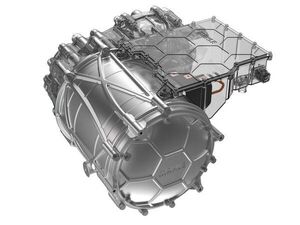
MAHLE develops highly efficient magnet-free electric motor
"MAHLE is currently developing a new kind of magnet-free electric motor that does not require rare earth elements. This not only makes production more environmentally compatible, but also brings advantages in terms of costs and resource security. The central feature of the new motor is the inductive and thus contactless power transmission—this allows the motor to operate wear-free and particularly efficiently at high speeds. The efficiency is above 95% at almost all operating points—a level that previously has only been achieved by Formula E racing cars. MAHLE has thus succeeded in combining the strengths of various electric motor concepts in one product. This new development is easily scalable, so it can be used in anything from subcompacts through commercial vehicles." [...]

SpaceX rocket launches Starlink fleet and 2 small satellites, sticks landing at sea
"A SpaceX Falcon 9 rocket launched a new fleet of Starlink internet satellites into orbit alongside two rideshare satellites Saturday evening (May 15), before sticking a stunning landing at sea. The veteran Falcon 9 rocket blasted off from Pad 39A at NASA's Kennedy Space Center here in Florida at 6:56 p.m. EDT (2056 GMT), marking the company's 15th launch of the year. It also marked the eighth flight for this particular Falcon 9. The successful liftoff marked the third time SpaceX launched one of its 229-foot-tall (70 meters) workhorse Falcon 9 rockets within as many weeks, as the company works to expand its burgeoning broadband constellation. Approximately nine minutes after liftoff, the rocket's first stage returned to Earth, touching down on SpaceX's drone ship "Of Course I Still Love You," for a 8th successful landing. A camera aboard the rocket stage captured spectacular video of the entire descent back to Earth." [...]

Salts Could Be Important Piece of Martian Organic Puzzle, NASA Scientists Find
"A NASA team has found that organic, or carbon-containing, salts are likely present on Mars, with implications for the Red Planet's past habitability. A NASA team has found that organic salts are likely present on Mars. Like shards of ancient pottery, these salts are the chemical remnants of organic compounds, such as those previously detected by NASA’s Curiosity rover. Organic compounds and salts on Mars could have formed by geologic processes or be remnants of ancient microbial life. Besides adding more evidence to the idea that there once was organic matter on Mars, directly detecting organic salts would also support modern-day Martian habitability, given that on Earth, some organisms can use organic salts, such as oxalates and acetates, for energy. “If we determine that there are organic salts concentrated anywhere on Mars, we’ll want to investigate those regions further, and ideally drill deeper below the surface where organic matter could be better preserved,” said James M. T. Lewis, an organic geochemist who led the research, published on March 30 in the Journal of Geophysical Research: Planets." [...]
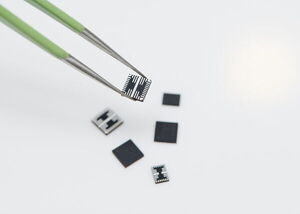
Samsung Unveils New Power Management Solutions for DDR5 Modules
"Samsung’s two new enterprise PMICs, S2FPD01 and S2FPD02, can reduce overheating with more than 90% energy-efficiency within the memory module The S2FPC01 offers power-saving benefits to PC DRAM modules in a compact form factor Samsung Electronics, a world leader in advanced semiconductor technology, today announced the industry’s first integrated power management ICs (PMICs) — S2FPD01, S2FPD02 and S2FPC01, for the fifth-generation double data rate (DDR5) dual in-line memory module (DIMM). One major design improvement to the newest generation DRAM solution involves integrating the PMIC into the memory module — previous generations placed the PMIC on the motherboard — offering increased compatibility and signal integrity, and providing a more reliable and sustained performance. For improved performance efficiency and load-transient responses, Samsung’s new PMICs for DDR5 modules have been equipped with a high-efficiency hybrid gate driver and a proprietary control design (asynchronous-based dual-phase buck control scheme). This scheme allows the DC voltage to step down from high to low with a fast transient response to changes in the output load current and adapts the conversion accordingly to efficiently regulate its output voltage at near-constant levels. The control scheme also features both pulse width and pulse frequency modulation methods, preventing delays and malfunctions when switching modes. “With enhanced power efficiency and low output ripple voltage, the new PMICs S2FPD01, S2FPD02 and S2FPC01 allow data centers, enterprise servers and PC applications to take full advantage of their DDR5 performance for highly demanding, memory-intensive tasks,” said Harry Cho, vice president of System LSI marketing at Samsung Electronics." [...]

STMicroelectronics acquires Edge AI software specialist Cartesiam
"STMicroelectronics (NYSE:STM), a global semiconductor leader serving customers across the spectrum of electronics applications, today announced a transaction with Cartesiam to acquire its assets (including its IP portfolio) and to transfer and integrate its employees. Closing is subject to regulatory approvals. Cartesiam, based in Toulon (France), is a software company founded in 2016, which specializes in artificial intelligence (AI) development tools enabling machine-learning and inferencing on Arm®-based microcontrollers, which today power billions of devices. Its team includes data scientists and embedded signal processing experts, with significant experience in delivering standard and custom solutions. Its flagship and patented solution, NanoEdge™ AI Studio, allows embedded systems designers without prior knowledge in AI to rapidly develop specialized libraries integrating machine-learning algorithms directly into a broad range of applications. Devices leveraging Cartesiam’s technology are already in production around the world included inside connected devices, household appliances, and industrial machines." [...]

Renesas Launches Entry-Level RZ/V2L MPUs with Best-in-Class Power Efficiency and High-Precision AI Accelerator
"DRP-AI Handles both AI Inference and Image Processing Functions, Eliminating External ISP Requirements and Enabling More Cost-Efficient Vision AI Implementations Renesas Electronics Corporation (TSE:6723), a premier supplier of advanced semiconductor solutions, today announced the expansion of its RZ/V Series of microprocessors (MPUs) with the new RZ/V2L MPUs designed for entry-level AI-enabled applications. As part of the RZ/V Series, the new MPUs incorporate Renesas’ exclusive AI accelerator – the DRP-AI (Dynamically Reconfigurable Processor) – to make embedded AI easier and more power efficient. The new RZ/V2L shares several features with its predecessor, the RZ/V2M, such as high-precision AI inference capabilities combined with top-class power efficiency. It also includes optimizations such as tailoring the DRP-AI operating frequency and memory interface for an entry-level MPU. The DRP-AI provides both real-time AI inference and image processing functions with the capabilities essential for camera support such as color correction and noise reduction. This enables customers to develop AI-based vision applications, such as point-of-sale (POS) terminals and robot vacuum cleaners, without requiring an external image signal processor (ISP)." [...]
Ciência e Tecnologia

Researchers develop algorithm to see inside materials with subatomic particles
"The School of Physical Sciences, in collaboration with the Science and Technology Facilities Council (STFC) and the Universities of Cardiff, Durham and Leeds, have developed an algorithm to train computers to analyse signals from subatomic particles embedded in advanced electronic materials. The particles, called muons, are produced in large particle accelerators and are implanted inside samples of materials in order to investigate their magnetic properties. Muons are uniquely useful as they couple magnetically to individual atoms inside the material and then emit a signal detectable by researchers to obtain information on that magnetism. This ability to examine magnetism on the atomic scale makes muon-based measurements one of the most powerful probes of magnetism in electronic materials, including “quantum materials” such as superconductors and other exotic forms of matter. As it is not possible to deduce what is going on in the material by simple examination of the signal, researchers normally compare their data to generic models. In contrast, the present team adapted a data-science technique called Principal Component Analysis (PCA), frequently employed in Face Recognition." [...]

Spintronics: Improving electronics with finer spin control
"DGIST scientists have found a novel way to control magnetic spins in a localized space. Scientists in Korea have found a new way to control the alignment state of magnetic atoms in an antiferromagnetic material, showing promise for the development of tiny sensors and memory devices. Researchers at the Daegu Gyeongbuk Institute of Science and Technology (DGIST) describe their new approach featuring a controllable exchange bias effect, which enables the asymmetric magnetic actions of devices comprised of complex combination structure of different types of magnetic materials, in the journal Acta Materialia. Spintronics is an emerging technology for manufacturing electronic devices that take advantage of electron spin and its associated magnetic properties, instead of using the electrical charge of an electron, to carry information. Antiferromagnetic materials are attracting attention in spintronics, with the expectation of spin operations with higher stability. Unlike ferromagnetic materials, in which atoms align along the same direction like in the typical refrigerator magnets, magnetic atoms inside antiferromagnets have antiparallel spin alignments that cancel out the net magnetization." [...]
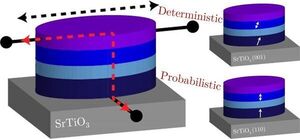
New material could create ‘neurons’ and ‘synapses’ for new computers
"Classic computers use binary values (0/1) to perform. By contrast, our brain cells can use more values to operate, making them more energy-efficient than computers. This is why scientists are interested in neuromorphic (brain-like) computing. Physicists from the University of Groningen have used a complex oxide to create elements comparable to the neurons and synapses in the brain using spins, a magnetic property of electrons. Their results were published on 18 May in the journal Frontiers in Nanotechnology. Although computers can do straightforward calculations much faster than humans, our brains outperform silicon machines in tasks like object recognition." [...]

NUS engineers harvest WiFi signals to power small electronics
"With the rise of the digital age, the amount of WiFi sources to transmit information wirelessly between devices has grown exponentially. This results in the widespread use of the 2.4GHz radio frequency that WiFi uses, with excess signals available to be tapped for alternative uses. To harness this under-utilised source of energy, a research team from the National University of Singapore (NUS) and Japan’s Tohoku University (TU) has developed a technology that uses tiny smart devices known as spin-torque oscillators (STOs) to harvest and convert wireless radio frequencies into energy to power small electronics. In their study, the researchers had successfully harvested energy using WiFi-band signals to power a light-emitting diode (LED) wirelessly, and without using any battery. “We are surrounded by WiFi signals, but when we are not using them to access the Internet, they are inactive, and this is a huge waste. Our latest result is a step towards turning readily-available 2.4GHz radio waves into a green source of energy, hence reducing the need for batteries to power electronics that we use regularly." [...]

EPFL works to address debris collision risk
"Space debris threatens human safety in space and puts at risk critical space-based infrastructure that supports services such as the internet, global navigation and climate monitoring. A new project from the EPFL International Risk Governance Center (IRGC), in collaboration with the EPFL Space Center (eSpace) and Space Innovation, is studying the governance of risks related to space debris and assessing policy options to ensure the safe and sustainable use of space. Human activity in space is accelerating rapidly. In 2020 alone, 1,200 satellites were launched. While there are currently around 3,400 operational satellites in space, there are plans to launch up to 60,000 more in the next decade. Many of these will make up large satellite constellations, which will provide telecommunication services." [...]
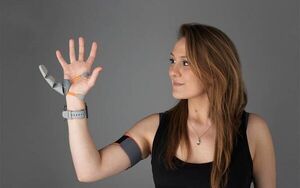
Robotic ‘Third Thumb’ use can alter brain representation of the hand
"The team trained people to use a robotic extra thumb and found they could effectively carry out dextrous tasks, like building a tower of blocks, with one hand (now with two thumbs). The researchers report in the journal Science Robotics that participants trained to use the thumb also increasingly felt like it was a part of their body. Designer Dani Clode began developing the device, called the Third Thumb, as part of an award-winning graduate project at the Royal College of Art, seeking to reframe the way we view prosthetics, from replacing a lost function, to an extension of the human body. She was later invited to join Professor Tamar Makin’s team of neuroscientists at UCL who were investigating how the brain can adapt to body augmentation. Professor Makin (UCL Institute of Cognitive Neuroscience), lead author of the study, said: “Body augmentation is a growing field aimed at extending our physical abilities, yet we lack a clear understanding of how our brains can adapt to it. By studying people using Dani’s cleverly-designed Third Thumb, we sought to answer key questions around whether the human brain can support an extra body part, and how the technology might impact our brain.” The Third Thumb is 3D-printed, making it easy to customise, and is worn on the side of the hand opposite the user’s actual thumb, near the little (pinky) finger." [...]
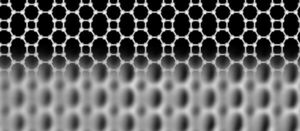
A new form of carbon
"Not graphene: researchers in Germany and Finland discover new type of atomically thin carbon material Carbon exists in various forms. In addition to diamond and graphite, there are recently discovered forms with astonishing properties. For example graphene, with a thickness of just one atomic layer, is the thinnest known material, and its unusual properties make it an extremely exciting candidate for applications like future electronics and high-tech engineering. In graphene, each carbon atom is linked to three neighbours, forming hexagons arranged in a honeycomb network. Theoretical studies have shown that carbon atoms can also arrange in other flat network patterns, while still binding to three neighbours, but none of these predicted networks had been realized until now. Researchers at the University of Marburg in Germany and Aalto University in Finland have now discovered a new carbon network, which is atomically thin like graphene, but is made up of squares, hexagons, and octagons forming an ordered lattice." [...]
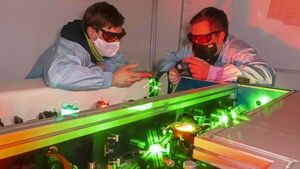
Making the invisible visible
"Researchers from Friedrich Schiller University Jena, the University of California Berkeley and the Institut Polytechnique de Paris use intense laser light in the extreme ultraviolet spectrum to generate a non-linear optical process on a laboratory scale – a process which until now has only been possible in a large-scale research facility. As the team writes in the current issue of the journal “Science Advances”, they were able to achieve this effect for the first time with a laser source on a laboratory scale and thus investigate the surface of a titanium sample down to the atomic level. Chemical reactions, such as those that occur when charging and discharging a battery, take place primarily on surfaces and at interfaces. While it is very easy to study the macroscopic products of a reaction, it has so far been difficult to gain a more accurate picture of the course of chemical reactions at the atomic level. This requires measurement methods that allow observations to be made on the extremely short time scales on which chemical reactions take place. In principle, spectroscopic methods with very short laser pulses for temporal resolution are suitable for this." [...]
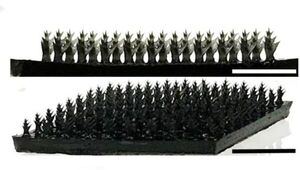
New Material Could Harvest Water All Day Long
"Micro-engineered, bioinspired design allows the material to collect moisture from cool fog as well as generating and collecting steam under sun Tiny structures inspired by the shape of cactus spines allow a newly created material to gather drinkable water from the air both day and night, combining two water-harvesting technologies into one. The material, a micro-architected hydrogel membrane (more on that later), can produce water through both solar steam-water generation and fog collection—two independent processes that typically require two separate devices. A paper about the material was published in Nature Communications on May 14. Fog collection is exactly what it sounds like. At night, low-lying clouds along sea coasts are heavy with water droplets. Devices that can coalesce and collect those droplets can turn fog into drinking water." [...]
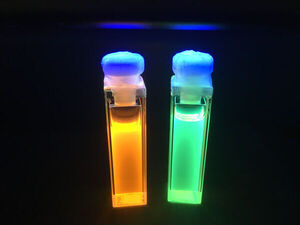
Electric cars: Special dyes could prevent unnecessary motor replacements
"One day in the near future dyes in electric motors might indicate when cable insulation is becoming brittle and the motor needs replacing. Scientists at Martin Luther University Halle-Wittenberg (MLU), together with ELANTAS, a division of the specialty chemicals group ALTANA, have developed a new process that enables the dyes to be directly integrated into the insulation. By changing colour, they reveal how much the insulating resin layer around the copper wires in the motor has degraded. The results were published in the journal "Advanced Materials". Modern combustion engines have long had detectors that recognise, for example, when an oil change is needed, saving unnecessary inspections. Electric motors also show signs of wear." [...]

A Solution to Space Junk: Satellites Made of Mushrooms?
"According to the latest numbers from the ESA’s Space Debris Office (SDO), there are roughly 6,900 artificial satellites in orbit. The situation is going to become exponentially crowded in the coming years, thanks to the many telecommunications, internet, and small satellites that are expected to be launched. This creates all kinds of worries for collision risks and space debris, not to mention environmental concerns. For this reason, engineers, designers, and satellite manufacturers are looking for ways to redesign their satellites. Enter Max Justice, a cybersecurity expert, former Marine, and “Cyber Farmer” who spent many years working in the space industry. Currently, he is working towards a new type of satellite that is made out of mycelium fibers." [...]

World first concept for rechargeable cement-based batteries
"Imagine an entire twenty storey concrete building which can store energy like a giant battery. Thanks to unique research from Chalmers University of Technology, Sweden, such a vision could someday be a reality. Researchers from the Department of Architecture and Civil Engineering recently published an article outlining a new concept for rechargeable batteries – made of cement. The ever-growing need for sustainable building materials poses great challenges for researchers. Doctor Emma Zhang, formerly of Chalmers University of Technology, Sweden, joined Professor Luping Tang’s research group several years ago to search for the building materials of the future. Together they have now succeeded in developing a world-first concept for a rechargeable cement-based battery." [...]

Quantum computing: cold chips can control qubits
"A cryogenic controller chip opens the door to solving the ‘wiring bottleneck’ and subsequently to realize a fully integrated, scalable quantum computer. A research from QuTech in the Netherlands, from Intel Corp and from EPFL professor Edoardo Charbon. A specially designed chip to control qubits can operate at extremely low temperatures, and opens the door to solving the ‘wiring bottleneck’. Researchers and engineers from QuTech in the Netherlands and from Intel Corp., jointly designed and tested the cryogenic chip and made an important step towards a scalable quantum computer. Their results are published in the scientific journal Nature. Each basic unit of a quantum computer, a qubit, is typically addressed individually by a single wire." [...]

Dark Energy Spectroscopic Instrument starts 5-year survey
"The Dark Energy Spectroscopic Instrument seeks to further our cosmic understanding by creating the largest 3D map of galaxies to date. Below is a press release issued by the Department of Energy’s Lawrence Berkeley National Laboratory announcing the official start of DESI’s five-year survey. DOE’s Fermi National Accelerator Laboratory is a key player in the construction of this instrument, drawing on more than 25 years of experience with the Sloan Digital Sky Survey and the Dark Energy Survey. Fermilab contributed key elements to DESI, including the online databases used for data acquisition and the software that will ensure that each of the 5,000 robotic positioners are precisely pointing to their celestial targets to within a tenth of the width of a human hair. Fermilab also contributed the corrector barrel, hexapod and cage. The corrector barrel holds DESI’s six large lenses in precise alignment." [...]

Ozone-depleting chemicals may spend less time in the atmosphere than previously thought
"New results point to unexpected, illegal production of several CFCs in recent years. MIT scientists have found that ozone-depleting chlorofluorocarbons, or CFCs, stay in the atmosphere for a shorter amount of time than previously estimated. Their study suggests that CFCs, which were globally phased out in 2010, should be circulating at much lower concentrations than what has recently been measured. The new results, published today in Nature Communications, imply that new, illegal production of CFCs has likely occurred in recent years. Specifically, the analysis points to new emissions of CFC-11, CFC-12, and CFC-113. These emissions would be in violation of the Montreal Protocol, the international treaty designed to phase out the production and consumption of CFCs and other ozone-damaging chemicals." [...]

Scientists Got Photons to Interact, Taking Step Towards Long-Living Quantum Memory
"An international research team obtained experimental evidence for effective interaction between microwave photons via superconductive qubits for the first time. The study, published in npj Quantum Materials, may be a step towards the implementation of a long-living quantum memory and the development of commercial quantum devices. Scientists believe that individual light particles, or photons, are ideally suited for sending quantum information. Encoded with quantum data, they could literally transfer information at the speed of light. However, while photons would make for great carriers because of their speed, they don’t like to interact with each other, making it difficult to achieve quantum entanglement. A team of scientists from NUST MISIS, Russian Quantum Center, the Ioffe Institute St. Petersburg and Karlsruhe Institute of Technology, for the first time, made photons interact with each other effectively using an array of superconducting qubits and a waveguide." [...]

Fibre-optics used to take the temperature of Greenland Ice Sheet
"Scientists have used fibre-optic sensing to obtain the most detailed measurements of ice properties ever taken on the Greenland Ice Sheet. Their findings will be used to make more accurate models of the future movement of the world’s second-largest ice sheet, as the effects of climate change continue to accelerate. The research team, led by the University of Cambridge, used a new technique in which laser pulses are transmitted in a fibre-optic cable to obtain highly detailed temperature measurements from the surface of the ice sheet all the way to the base, more than 1,000 metres below. In contrast to previous studies, which measured temperature from separate sensors located tens or even hundreds of metres apart, the new approach allows temperature to be measured along the entire length of a fibre-optic cable installed in a deep borehole. The result is a highly detailed profile of temperature, which controls how fast ice deforms and ultimately how fast the ice sheet flows. The temperature of ice sheets was thought to vary as a smooth gradient, with the warmest sections on the surface where the sun hits, and at the base where it’s warmed by geothermal energy and friction as the ice sheet grinds across the subglacial landscape toward the ocean." [...]

Flying at Speeds up to Mach 17 Could Become Reality with UCF’s Developing Propulsion System
"The UCF-developed propulsion system could allow for flight speeds of Mach 6 to 17 (more than 4,600 to 13,000 miles per hour) and would have applications in air and space travel. University of Central Florida researchers are building on their technology that could pave the way for hypersonic flight, such as travel from New York to Los Angeles in under 30 minutes. In their latest research published Monday in the journal Proceedings of the National Academy of Sciences, the researchers discovered a way to stabilize the detonation needed for hypersonic propulsion by creating a special hypersonic reaction chamber for jet engines. “There is an intensifying international effort to develop robust propulsion systems for hypersonic and supersonic flight that would allow flight through our atmosphere at very high speeds and also allow efficient entry and exit from planetary atmospheres,” says study co-author Kareem Ahmed, an associate professor in UCF’s Department of Mechanical and Aerospace Engineering. “The discovery of stabilizing a detonation — the most powerful form of intense reaction and energy release — has the potential to revolutionize hypersonic propulsion and energy systems.” The system could allow for air travel at speeds of Mach 6 to 17, which is more than 4,600 to 13,000 miles per hour. The technology harnesses the power of an oblique detonation wave, which they formed by using an angled ramp inside the reaction chamber to create a detonation-inducing shock wave for propulsion." [...]
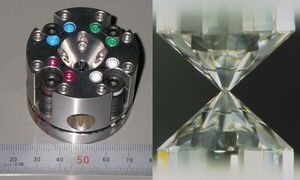
Where on Earth is all the water?
"High-temperature and high-pressure experiments involving a diamond anvil and chemicals to simulate the core of the young Earth demonstrate for the first time that hydrogen can bond strongly with iron in extreme conditions. This explains the presence of significant amounts of hydrogen in the Earth’s core that arrived as water from bombardments billions of years ago. Given the extreme depths, temperatures and pressures involved, we are not physically able to probe very far into the earth directly. So, in order to peer deep inside the Earth, researchers use techniques involving seismic data to ascertain things like composition and density of subterranean material. Something that has stood out for as long as these kinds of measurements have been taking place is that the core is primarily made of iron, but its density, in particular that of the liquid part, is lower than expected. This led researchers to believe there must be an abundance of light elements alongside the iron." [...]

Researchers Develop 3D-Printed Jelly
"Hydrogels merge two physical forms of the same seaweed material for strength, flexibility. 3D-printable gels with improved and highly controlled properties can be created by merging micro- and nano-sized networks of the same materials harnessed from seaweed, according to new research from North Carolina State University. The findings could have applications in biomedical materials – think of biological scaffolds for growing cells – and soft robotics. Described in the journal Nature Communications, the findings show that these water-based gels – called homocomposite hydrogels – are both strong and flexible. They are composed of alginates – chemical compounds found in seaweed and algae that are commonly used as thickening agents and in wound dressings. Merging different-size scale networks of the same alginate together eliminates the fragility that can sometimes occur when differing materials are merged together in a hydrogel, says Orlin Velev, S. Frank and Doris Culberson Distinguished Professor of Chemical and Biomolecular Engineering at NC State and corresponding author of the paper." [...]

Electrons riding a double wave
"Research team presents a new type of particle accelerator Since they are far more compact than today’s accelerators, which can be kilometers long, plasma accelerators are considered as a promising technology for the future. An international research group has now made significant progress in the further development of this approach: With two complementary experiments at the Helmholtz-Zentrum Dresden-Rossendorf (HZDR) and at the Ludwig-Maximilians-Universität Munich (LMU), the team was able to combine two different plasma technologies for the first time and build a novel hybrid accelerator. The concept could advance accelerator development and, in the long term, become the basis of highly brilliant X-ray sources for research and medicine, as the experts describe in the journal Nature Communications (DOI: 10.1038/s41467-021-23000-7). In conventional particle accelerators, strong radio waves are guided into specially shaped metal tubes called resonators. The particles to be accelerated – which are often electrons – can ride these radio waves like surfers ride an ocean wave. But the potential of the technology is limited: Feeding too much radio wave power into the resonators creates a risk of electrical charges that can damage the component." [...]
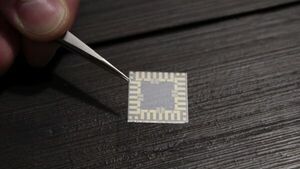
Printed Circuits Protect Sensors
"“sensIC” joint project combines materials science and cybersecurity – PUFs serve as electronic identification features Electronic sensors can benefit many industrial applications, such as automotive engineering. However, they have to be protected from attacks and falsification. The new joint project entitled “sensIC” aims to integrate printed electronics and silicon components directly into products in order to secure sensors. At the Karlsruhe Institute of Technology (KIT), researchers are developing a key component for this: printed security circuits with dedicated hardware-based functions, so-called Physical Unclonable Functions (PUFs). The Federal Ministry of Education and Research is funding “sensIC” with a total of 2.9 million euros. The industry partners are investing a further 1.35 million euros in this project." [...]

New Research Could Help Manufacturers Avoid 3D-Printing Pitfall
"For destressing printed metal parts, ‘island scanning’ may not be the cure-all after all. A research team has found that a method commonly used to skirt one of metal 3D printing’s biggest problems may be far from a silver bullet. For manufacturers, 3D printing, or additive manufacturing, provides a means of building complex-shaped parts that are more durable, lighter and more environmentally friendly than those made through traditional methods. The industry is burgeoning, with some predicting it to double in size every three years, but growth often goes hand in hand with growing pains. Residual stress, a byproduct of the repeated heating and cooling inherent to metal printing processes, can introduce defects into parts and, in some cases, damage printers. To better understand how residual stress forms, and how it might be curbed, researchers at the National Institute of Standards and Technology (NIST), Lawrence Livermore National Laboratory, Los Alamos National Laboratory and other institutions closely examined the effects of different printing patterns in titanium alloy parts made with a common laser-based method." [...]

Hanging by a Thread: Imaging and Probing Chains of Single Atoms
"Scientists develop a method to visualize monoatomic chains and measure the strength and conductance of single-atom bonds Low-dimensional materials, such as 1D monoatomic chains, exhibit exotic properties that could find interesting applications. However, single-atom bonds and their mechanical characteristics are difficult to study. In a recent study, scientists from JAIST, Japan, showcase a novel method to simultaneously image monoatomic platinum chains with a transmission electron microscope while measuring their bond strength and conductance during mechanical stretching. This technique will help answer many questions in the fields of nanomechanics and surface science. Today, many well-studied materials in various fields, such as electronics and catalysis, are close to reaching their practical limits. To further improve upon modern technology and outperform state-of-the-art devices, researchers looking for new functional materials have to push the boundaries and explore more extreme cases." [...]

Thin is now in to turn terahertz polarization
"Rice lab’s discovery of ‘magic angle’ builds on its ultrathin, highly aligned nanotube films It’s always good when your hard work reflects well on you. With the discovery of the giant polarization rotation of light, that is literally so. The ultrathin, highly aligned carbon nanotube films first made by Rice University physicist Junichiro Kono and his students a few years ago turned out to have a surprising phenomenon waiting within: an ability to make highly capable terahertz polarization rotation possible. This rotation doesn’t mean the films are spinning. It does mean that polarized light from a laser or other source can now be manipulated in ways that were previously out of reach, making it completely visible or completely opaque with a device that’s extremely thin. The unique optical rotation happens when linearly polarized pulses of light pass through the 45-nanometer film and hit the silicon surface on which it sits." [...]

Graphene enables ten times higher data storage in computer memories
"Researchers at Graphene Flagship Partners the University of Cambridge, UK, Ecole Polytechnique Fédérale de Lausanne (EPFL), Switzerland, Empa-Swiss Federal Laboratories for Material Science and Technology, Switzerland and Graphene Flagship Associate Member the University of Exeter, UK, in collaboration with colleagues at CSIR-Advanced Materials and Processes Research Institute, India, National University of Singapore (NUS), A*STAR (Agency for Science, Technology and Research), Singapore, the University of Illinois and Argonne National Laboratory, US, have demonstrated that graphene can be used to produce ultra-high density hard disk drives (HDD). This can lead to the development of ultrahigh density magnetic data storage: a big jump from the current one terabit per square inch (Tb/in2) to ten terabits over the same area. HDDs first appeared in the 1950ies, but their use as storage devices in personal computers only took off from the mid-1980s. They have become ever smaller in size, and denser in terms of the number of stored bytes. While solid state drives are popular for mobile devices, HDDs continue to be used to store files in desktop computers, largely due to their favourable cost to produce and purchase. HDDs contain two major components: platters and a head." [...]
Documentação
A documentação é parte essencial do processo de aprendizagem e a Internet além de artigos interessantes de explorar também tem alguma documentação em formato PDF interessante de ler. Todos os links aqui apresentados são para conteúdo disponibilizado livremente pelo editor do livro.
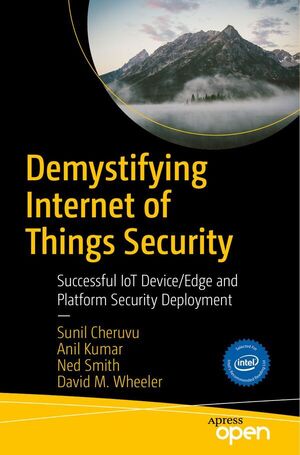
Demystifying Internet of Things Security
"Break down the misconceptions of the Internet of Things by examining the different security building blocks available in Intel Architecture (IA) based IoT platforms. This open access book reviews the threat pyramid, secure boot, chain of trust, and the SW stack leading up to defense-in-depth. The IoT presents unique challenges in implementing security and Intel has both CPU and Isolated Security Engine capabilities to simplify it. This book explores the challenges to secure these devices to make them immune to different threats originating from within and outside the network. The requirements and robustness rules to protect the assets vary greatly and there is no single blanket solution approach to implement security. " [...]
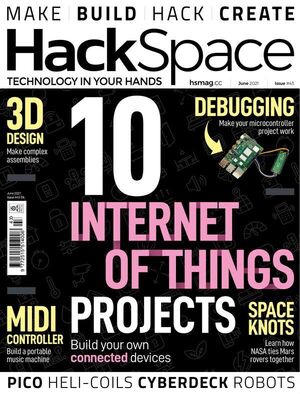
HackSpace magazine #43
"The internet of things can work for you: all you have to do is do it yourself! Inside this issue we look at 10 of the best DIY internet of things projects to inspire and delight you, and maybe even give you the idea for the next world-beating device. - Debug hardware on Raspberry Pi Pico and ESP32 - Fix stripped threads the quick way - Design complex assemblies in FreeCAD - Tie NASA-grade knots" [...]
Projetos Maker
Diversos Projetos interessantes.
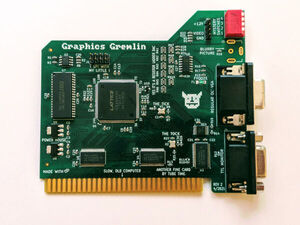
The Graphics Gremlin - a Retro ISA Video Card
"The Graphics Gremlin is an FPGA-based ISA video card specifically designed to emulate certain old video standards. This initial release emulates the original IBM PC monochrome graphics adapter (MDA) as well as the original IBM color graphics adapter (CGA). Since the logic is defined by the bitstream loaded into the FPGA, new emulations may be available in the future to support other video standards. But why emulate an old video card when they are still fairly easy to find online? Cards aren't hard to find, but monitors that can sync to the unusual frequencies used by MDA (18KHz) and CGA (15KHz) are much harder to find, and these frequencies are rarely supported by modern LCD monitors or video capture hardware. For both MDA and CGA, the Graphics Gremlin has a VGA port that can deliver video running at standard (31KHz) frequencies that are well supported by LCD monitors, VGA-to-HDMI converters, and USB capture devices." [...]

CircuitPython Libraries on MicroPython using the Raspberry Pi Pico
"Blinka is our CircuitPython compatibility layer. It was originally written as a compatibility layer to run on top of MicroPython to work on boards such as the PyBoard and allow libraries written for CircuitPython to work. This allowed more library re-use and fewer libraries that needed to be maintained. Blinka was soon adapted to work on Linux-based Single Board Computers to allow those same libraries to work on boards such as the Linux-based Raspberry Pi computers (not to be confused with the Raspberry Pi Pico microcontrollers). It gained a lot of popularity there was expanded to run on many more boards. It wasn't used much on MicroPython at that point and there weren't many guides that showed how to run Blinka over MicroPython." [...]

Calculator Made of Discrete Transistors
"Have you wondered how computers compute things at the hardware level? I was curious so I made a binary calculator using only transistors. Story I always was curious about how computers worked at a hardware level. When I finally learned about the principle of operation while studying Digital Logic Course while doing my Engineering degree in Electronics. I finally had an answer to my question. However I always wanted to use this knowledge to design and build my own logic circuits not by using gates but by using discrete transistors themselves." [...]

PyUPDI Programmer
"Probably the simplest UPDI programmer for tinyAVR, megaAVR and AVR-Dx microcontrollers. The programmer works with pyupdi as well as with the Arduino IDE as "Serial Port and 4.7k (pyupdi style)". It is based on the USB-to-serial chip CH330N. " [...]
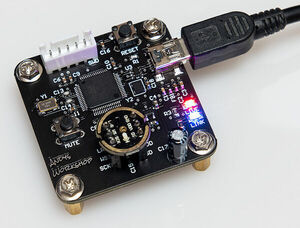
A USB microphone for online meetings
"Here in the UK the new reality of working in the IT business over the past year has been that we’re all at home working remotely over virtual desktop connections and for someone engaged in software development this is a setup that works well. Having to commute 90 minutes each way into London every day on the train is not something I’ll ever miss. Team meetings are still an important part of the day though and that meant digging out and dusting off my old webcam, a Logitech something-or-other that works fine in every scenario except when I use it through my company’s Citrix-hosted virtual desktop. The video is fine but the audio frequency on the VDI is mismatched to the actual frequency on the physical device. I sound like Mickey Mouse on helium. This is a well-known problem and the solution is to change the frequency on the VDI, which requires administrator level access." [...]
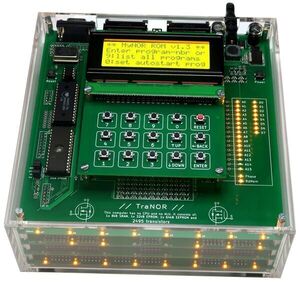
TraNOR - A computer built with transistors
"This is not a transistor computer. In fact, it is a computer with a CPU made up of discrete transistors, and the CPU instructions are composed by microcode stored in the same memory that also contains the application program. This computer consists of 1897 transistors for the CPU, 598 transistors for the four 8-bit I/O-ports and additional 124 transistors for the LCD I/O board. Furthermore, three integrated memory chips were used. Of course it would be possible to build the SRAM chip with transistors and the ROM chip with transistors and diodes as well, but this would have required much more transistors. The complexity of my design is somewhere between the Intel i4004 CPU (2250 transistors) and the 6502 (3218 transistors)." [...]
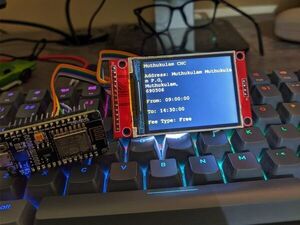
Get Vaccine availability with Arduino
"I made hardware that notifies me when slots are available. All of you know how difficult it has been to find a vaccine slot through the government website owing to how quickly it gets filled up. People soon realised that the Govt. of India made the API to check vaccine slot availability public and started building all sorts of bots like WhatsApp Bot, telegram bot, twitter bot etc. that sends a notification when vaccine slot is available. And it basically became an unofficial nation-wide hackathon Me being a hardware enthusiast decided to make a hardware device that notifies me when a slot is available." [...]

Create a USB Microphone with the Raspberry Pi Pico
"This guide will walk you through creating a USB microphone on the Raspberry Pi Pico using the RP2040's PIO, DMA, and USB capabilities. Introduction This guide will walk through how to create your own USB microphone device using a Raspberry Pi Pico board and an external digital microphone. This project will leverage the Programming I/O (PIO), Direct Memory Access (DMA), and Universal Serial Bus (USB) capabilities of the boards RP2040 microcontroller (MCU). USB USB is an extremely popular standard, released in 1996, for wired computer peripherals, such as keyboards, mice, printers, scanners, and microphones. The Raspberry Pi Pico board's RP2040 MCU has a "USB 1.1 Host/Device" feature, which allows you to either connect to an existing USB peripheral device (host mode) or create your own USB peripheral (device mode). The Raspberry Pi Pico SDK uses the TinyUSB library as its USB software stack." [...]
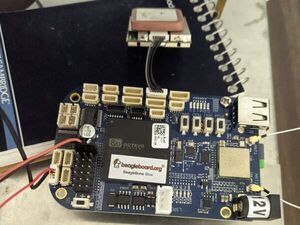
ArduPilot Rover and the BBBlue (2021)
"Did you want a slow, controlled robot from ArduPilot and make it work with the BBBlue? Good luck! Until now! I first want to start off with these tidbits of info: Rover seems easy to install on the BBBlue at first Cross-compilation is an option Native-compilation is another option (this will take a long time) Getting everything correct...priceless" [...]
A Pixel Purse LED Cube Controlled by a Cisco 3G Modem
"I presented this project at BangBangCon West 2020, but never got around to publish a blog post about it. A 10 minute talk is not enough to cover some technical aspects, and since I’m starting to forget them, it’s about time to write things down. I can’t pinpoint exactly when it happened, but there was a time, between 2018 and 2020, when LED cubes were a bit of thing in the world of hobby electronics. " [...]

Xiao Mx MIDI Device
"A simple MIDI device that uses the Adafruit TinyUSB library, a Seeed Studio Xiao, 6 Cherry Mx stabilised switches and 5 9mm Alpha pots. " [...]

Blynk - creating a local server with a Raspberry Pi
"Blynk, is it the savour of microprocessors everywhere? Well at first look this seems to show promise, so let's take it for a spin and see. While looking for a unique way to control a two-stage green-house, I came across "Blynk". ( https://docs.blynk.cc ) I just followed the very simple and easy instructions at Github/Blynk. I got a working server on a Raspberry Pi in no time! Follow this link below for complete instructions on setting up your own server, note that if you are going to use a local server, you will have no access to your network and the server if you are not connected to the network the server is on." [...]
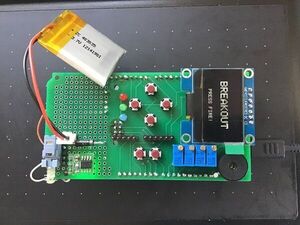
XpandShield
"An Arduino Shield that is compatible with Arduino Leonardo or DUE (and potentially many more!). It started 2020 winter when things start to get cold. How cold? We do not have a good thermometer at home. The one on the alarm clock is 10 degrees away from what it is, and the one on the air-con controller jumps around. The mechanical one is broken and no "traditional" ones are found." [...]

IOT Based Fertilizer System for Smart Agriculture
"Real-time visibility and control of water, Nitrogen-Phosphorus-Potassium - from any where an Internet of Things (IoT) based system. My country India has been badly affected by climate change due to heavy deforestation. So many campaigns arose planting more trees. However, to reduce my effort in gardening, I made something that watering and fertilizing my plants based on an Blynk app. The plants often get neglected at holiday time and so this watering and feeding system was made and installed so that the plants were irrigated all the time.The mixing tank is filled with water through the solenoid valve. The peristaltic pumps dose the tank with the required amount of fertilizer and then the mixer pump is turned off." [...]

Low-Latency Teleoperation with Raspberry Pi and Surrogate.tv
"Learn how to connect your Raspberry Pi to the Surrogate. tv platform and create real-life games that other people can play over the internet! Surrogate.tv is a platform that allows you to easily create remote play and teleoperation experiences, even if you don't know how to code. You can connect things like consoles, robots, RC cars, robots, or anything else to the internet and let anyone in the world control it remotely. In this guide we will show you how to set up your hardware, connect to the platform and become a creator on Surrogate.tv. This guide is aimed at people who've never created a game on Surrogate.tv: we will begin from scratch, and within an hour you should have your very own game up and running on Surrogate.tv!" [...]

How to Make a Musical Solid State Tesla Coil (SSTC) That Plays Guitar!
"This is my first Solid State Tesla Coil (SSTC), which I think has turned out pretty well! My intention was more towards it playing music rather than huge sparks, but I got about 6in sparks from it too which is a bonus. The aim of this instructable is to explain what Tesla Coils (TC) are, how they work, a couple of variations and and also how to make one! To make a TC you really need to know exactly how they work (you can't build one successfully by blindly following instructions). I did a lot (and i mean A LOT) of research into how to make one, and I feel like I should give back some information that I discovered whilst making mine. I first want to say that you'll be playing with very high voltages (and high current!" [...]
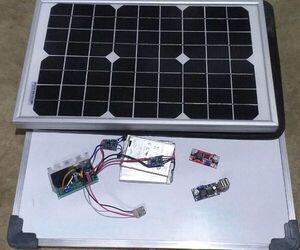
Making Your Own Photovoltaic 5V System
"This uses a buck converter as a 5V Output to charge the battery(Li Po/Li-ion). And Boost converter for 3.7V battery to 5V USB output for devices needed 5 V. Similar to the Original system that uses Lead Acid Battery as an energy storage charge by either PWM or MPPT controller. And supply for 12V Devices. This One only uses a Buck converter to convert 12V (solar panel nominal voltage) to stable 5V to charge a Li-Po/Li-ion battery, after daylight. Switch to Boost converter to convert the battery's voltage 4.2 (3.7 nominal voltage for Li-Po and Li-ion) to again 5V for devices powers 5V. (You can still use the 5V in the Buck Converter during daytime while the Li-Po/Li-ion Battery is charging." [...]

Ultra Low Power IR Remote Control
"This IR remote control is powered only while one of its buttons is pressed. To watch TV I needed two IR remote controls, one for my TV set and the other one for my decoder. I wanted to combine them into a single one. The Arduino Project Hub contains several projects that describe IR remote controls, but the specificity of this one is that it is battery powered and that the battery saving has been maximized as far as possible. Description The code of this project is specific to the remote controls it replaces, and you can find codes for IR remotes in several projects on the Arduino hub. So I won't describe my code, and I will only show the hardware solution which allowed power consumption to be limited to the strict minimum." [...]
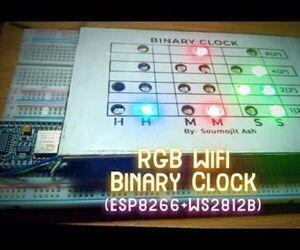
RGB Wifi Binary Clock (ESP8266+WS2812b)
"Hey guys, in this tutorial I will show how to make a cool RGB binary clock with esp8266 and WS2812b addressable RGB Leds that updates time from internet. Leds and IoT is the things I most like, So I was thinking to build a binary clock and I didn't had any RTC module, I got some esp8266 (nodemcu and esp01) laying around, So I used some addressable Leds to drive all of them with only one data pin and used NTP to get the time from the Internet. That's how I got the idea to build this. " [...]
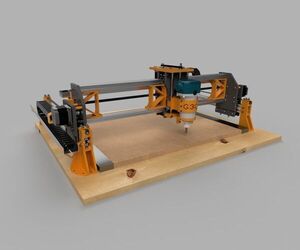
G300 - 3D Printed CNC Machine
"About 6 months ago I started designing a cnc machine that allowed me to carry out some milling works; the design phase was very demanding in terms of time because it involved both the mechanical and the electronic parts.I decided to call this machine G300 because 300 is the overall spending target that I set myself, which I was able to meet. I intend to use the G300 mainly on wood and plastic sheets (PP and PE) but I believe it can also be used for aluminum. INSPIRATION Before starting I analyzed some of the existing projects and I particularly appreciated the works of Nikodem Bartnik and Topsie, whom I thank for the contribution they have given to the world of open CNCs and for having given the community some beautiful projects from which, I too was able to draw inspiration. DESIGN AND STRUCTURAL CHOICES In the creation of my proposal I was inspired by existing solutions and I evaluated each component with my personal ranking of importance: does it allow me to meet the target budget? is it an optimal solution? is it strong enough?" [...]

Gesture Sensing E-textiles
"After playing around with Freetouch to make a knitted fabric switch, it was found that the sensor reading varied depending on the type of interactions. For example, prodding the fabric resulted in a much lower sensor reading than grabbing the fabric. Based on this observation, I played around with how to use Freetouch and knitted e-textiles to make a gesture sensing e-textile based on capacitive sensing. This project is designed to be guidance for making your own gesture sensing e-textiles, based on what I found to work, and not work so well. " [...]

The Kid Clock / Une Horloge Pour Les Petits (Bilingue)
"Wondering if you can build this cute clock for kids ? Don't hesitate, it's a no brainer ! I made this little clock for one of my grand daughter: she is not yet able to tell the time and was often confused between night and day when waking up from an afternoon nap. So, the clock displays various elements depending on the current time: a rising sun in the morning, a full sun and a cat during the day, a setting sun in late afternoon, an owl, a moon and twinkling stars at night. No more confusion now, it helped her to better understand the time and she likes it very much. I believe this tutorial is very accessible to all electronics DIYers, you will find step by step explanations to build and customize it as you want." [...]

DIY ESP-01 WIFI Module Programming Adapter
"Hello fellow makers! In this instructable I will show you how you can make your own ESP-01 programmer using a FTDI Module and some basic components. Also, i will show how to setup your Arduino IDE for the programming of ESP-01 Module. Hardware: Perforated PCB 4 Pin Female Header X 2 6 Pin Female Header Thin enameled copper wire SPDT momentary switch Generic Latch switch ESP8266 ESP-01 WIFI Module FTDI USB to TTL Programming Module USB A to USB mini A cable Software: Arduino IDE Tools: Soldering Iron Solder wire" [...]

Simon Says Box
"Authors: Jackelyn Garcia- [email protected] Hector Villalobos- [email protected] Allan Hambly- [email protected] (For more questions contact us at our emails above) Here is the YouTube video for our project: Acknowledgements: California Maritime Academy (ET Department) Professor Chang-Siu Erin Cole Gage Sturgeon Jack Whelan The Idea: The Simon Says Box is a combination between the game Simon and an Arduino project called The Useless Box, along with our own touches. In our game, there are four different colored LEDs that will randomly display a sequence of colors. At the start of the game, one color is displayed in which the player is to correctly match it by pressing the corresponding colored button. If the color is correctly matched, the game will add a second color in addition to the first. Each time the colors displayed are matched in the correct order, the players moves on to the next level where one more color is added to the previous pattern. This tests the player's ability to memorize the patterned sequences and makes it more challenging as they move on to each level." [...]
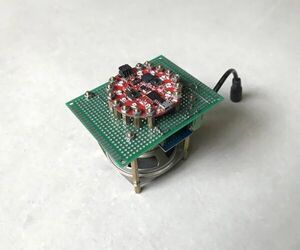
Talking Clock
"Today, I would like to share how to build a "Talking Clock" based on Adafruit Circuit Playground Express board, which can notify the real time, temperature and light level by voice. The main components are included: 1pcs x Adafruit Circuit Playground Express. 1pcs x Speaker. 1pcs x DS3231 Real Time Clock Module. 1pcs x AMS1117 3.3V Power Supply Module. 1pcs x Double Side DIY PCB 7x9cm." [...]
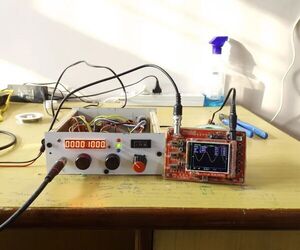
Function Generator (AD9833 Based)
"Hi, I am Gursimran Singh In this Instructable, I will guide you through on how to make a "functional" function generator, which can be very helpful when working with electronic circuits. A function generator can generate different kinds of signals like sine wave, square wave or even a triangular wave at a particular frequency set by the user. The design explained in this ible uses AD9833 which can ideally generate frequencies up to 12.5 MHz as per the datasheet. I came across AD9833 when reading this project by Cezar Chirila. I will explain the problems I encountered and how I got rid of them in upcoming steps. Also, you'll learn how to fabricate your own PCB at home." [...]
Tic Tac Toe (Arduino Uno and Neo Pixels)
"Tic Tac Toe is a two player game in which the players compete to get 3 pieces in a row. In this project we constructed a Tic Tac Toe game using a number pad and neo pixels as pieces. This results in a portable Tic Tac Toe game requiring only a wall outlet to play. " [...]

ATtiny85 Bluetooth Automation With Button Feedback
"A Simple ATtiny85 Controller-based Bluetooth controlled Relay for Home Automation with Manual Button having Real-Time Feedback status of Button. Can control it by Mobile Application as well as Manual Button too. Electronic Components ICs ATtiny85 7805 Module Bluetooth Module HC-05 Diodes 1N4007 (2) LED Capacitors 0.1 u (2) 10 uF 100 uF Resistors 1K (3) 2K 4.7k 10k 1M Transistor BC547 8 Pin IC Base Relay 12 SPDT Push Button Buzzer AC Connector DC in Connector MOV PCB" [...]
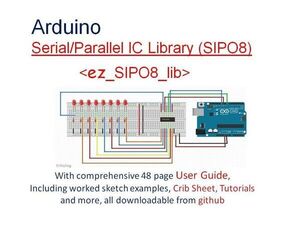
Command & Control of Multiple Serial-In/Parallel-Out ICs
"Design projects using many 100's of output pins, using banks of serial-parallel ICs, up to 255 ICs/2040 output pins, on minimal digital pins The ez_SIPO8 Library Introduction - More from Less Arduino microcontrollers are great for offering readily usable digital and analogue I/O pins for connecting to the outside world; some boards have few, some have many (eg MEGA 2560). But sometimes there just aren't enough for our project or we want to keep their use to a minimum. This is where the humble and low cost Serial-Parallel Integrated Circuit (SIPO IC) comes to our rescue! SIPO ICs offer us significant reductions in microcontroller pin usage, a factor of at least 3:8 for a singly wired 8bit IC and much, much better ratios if we connect them in a cascade (daisy chain). For example, if we cascade 4 SIPO ICs this improvement increases to 3:32! Even greater efficiencies can be leveraged." [...]

3D Artificial Horizon - Gyroscope with MPU6050 GY-521
"After many hours of work, I present thee! Navi, the NavBall! Based on the Navball in Kerbal Space Program. Als works with mouse, or ADXL345. 3D Artificial Horizon/ Gyroscope Using Arduino and Processing3+ Works with mouse if desired. Also works with ADXL345 and MPU6050/GY-521 Accelerometer/Gyroscope variations." [...]
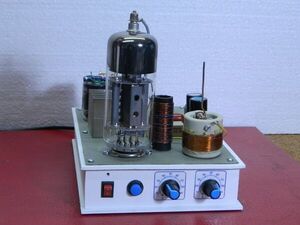
DIY Plasma Tweeter (speaker)
"This project describes the making of an unusual tweeter speaker that is much appreciated in the high-end audio class. This time I will show you how to make a Plasma Tweeter. In some of my previous videos you could see an audio modulated Tesla coil in which also the input audio signal is modulated and the spark reproduces this input signal as a standard speaker. However, the sound quality is desperate and there can be no question of any use in audio systems. The video above describes the making of an unusual tweeter that is much appreciated in the high-end audio class. The cost of a pair of such speakers is in the range of several thousand dollars." [...]
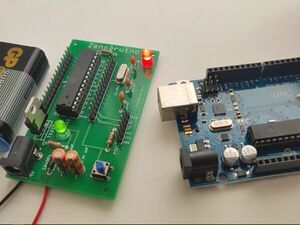
Diy Arduino (ZenoDruino)
"Hey folks I am here with my design of arduino it is a very simple project simple soldering and all the components are in dip package. Hey guys today iam gonna make my own version of arduino, its kind of so simple for begginers to explore the world of arduino, this will be my first version of arduino and I like to update to new versions of arduino with smd packages and coustom boards for new projects so this will be my V.1 board, my main aim is to make boards for my own projects like coustom boards, this will be executed in the near future if you are with me and I hope you read till this far if you done that u really need to get apppreciated, in sort of return do check my youtube channel and subscribe this make me incited to make more videos stay happyalways :)" [...]
Run BASIC on a BBC micro:bit
"It was recently BASIC’s 57th birthday, the programming language many of us first used to do any computer programming on computers from the 1970s and 1980s like the Commodore PET, Sinclair ZX Spectrum or Apple 2. Worth remembering too that part of the team that created BASIC was Sister Mary Kenneth Keller, the first woman and one of the first people in the US to get a PhD in computer science. I’d known for a while that there was a Japanese port of TinyBASIC for the BBC micro:bit. To be honest I thought it was a bit of a novelty as you need a computer to connect to it that will be more powerful than the micro:bit and able itself to run proper BASIC, but it’s actually very, very clever. It will allow you to access features of the micro:bit itself, like the LED display, the buttons, GPIO pins and so on, meaning you can do real physical computing with the micro:bit in BASIC. You don’t need any special hardware, just a micro:bit and some sort of serial terminal on a computer connected to the micro:bit by USB." [...]

Women Safety Device with GPS Tracking
"Here we will build a band that can be worn by women, using which they can inform police or anyone, using SOS emergency SMS along with the current location. With all the technology available to us in recent times, it's not hard to build a safety device for women which will not only generate an emergency alarm but also send a message to your friends, family, or concerned person. Here we will build a band that can be worn by women, using which they can inform police or anyone, using SOS emergency SMS along with the current location. Using this information, the police will be able to save the victim from the location. For this, here we are using an ESP8266 which can be interfaced with GSM and GPS module for sending SMS alerts and getting the location coordinates. " [...]

DIY Smart Plant
"Take care of your plant automatically Having plants require to take care of them and give them water everyday. But when you have to work around the clock, you don't have the time or just can forget to water your precious plant. To evoid letting the plants die, I have created a sytsem watering them automatically. For this project we need to water plants so we will use a 12V pump controlled by a relay, a water sensor to know the level of the water which is coupled to a strip led, a soil moisture sensor to measure the volume of water in the earth and a photoresistor that will stop the system during the night. " [...]
Secção Videos
Videos interessantes.
That's all Folks!



